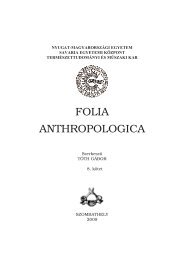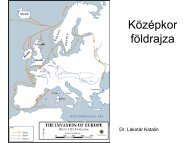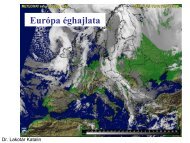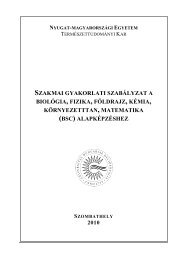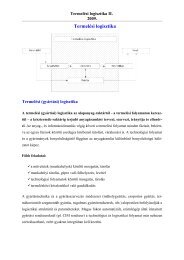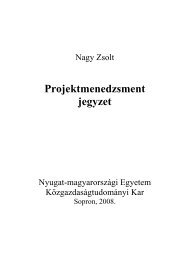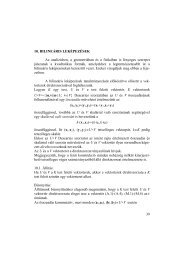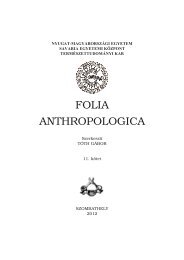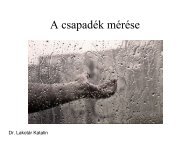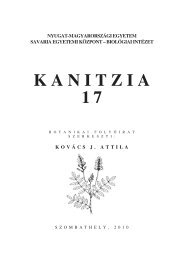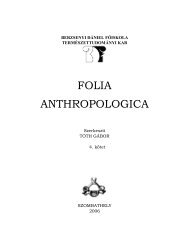Kanitzia 18. - NYME Természettudományi Kar - Nyugat ...
Kanitzia 18. - NYME Természettudományi Kar - Nyugat ...
Kanitzia 18. - NYME Természettudományi Kar - Nyugat ...
Create successful ePaper yourself
Turn your PDF publications into a flip-book with our unique Google optimized e-Paper software.
anean influences are obvious. The existence of numerous marshes in the Carpathian Mts.<br />
should not be neglected, covering numerous glacial relics. Some species of this list belong<br />
to the category of rare species, endangered in Romania and were recently presented in the<br />
newly published “Red Book of Vascular Plants in Romania” (DIHORU & NEGREAN 2009).<br />
Besides the very rare species, many plants belong to the Red list of superior Plants in Romania<br />
(OLTEAN, NEGREAN & al. 1994). According to our statistical data, about 4000 major<br />
taxa are indicated in Romania. Among them the endemic elements are very important:<br />
would be about 120 taxa in South East Carpathians (Dacic elements - fide Pax); about 12<br />
taxa in Dobrudja (Scythic elements - G. Negrean ined.); about 10 taxa in Romanian Plain,<br />
northern part of Bularia, Bulgarian Plain and Moldova Plateau (Gethic elements, ined.);<br />
about 5 taxa in the Transylvanian Basin (Transylvanian elements); about 7-8 taxa in Tisa<br />
Plain, Romanian Part [or planitia transtibiscensis, pars romaniae /nomen fide Soó and Negrean,<br />
ined./ Danubian elements (fide Meusel): Pannonian elements]. The Danubian elements<br />
(fide Meusel) are divided (in my opinion) in two: pannonic elements (Carpathian<br />
Basin: Pannonian Plain and margins) and Gethic elements (Romanian Plain, Bulgarian<br />
Danubian Plain and Moldavian Plain and Plateau).<br />
The first plants from the historical Dacia were mentioned by Dioscorides (1499,<br />
1518, 1906), and largely commented in the specialty literature, also having illustrations of<br />
high value. Same old illustrations are those on the metopes of the monument sacred to the<br />
Emperor Trajan: Tropaeum Trajani; as well as those on the Trajan column in Rome, whose<br />
constructor architect accompanied the Roman troops in the expeditions of Dacia conquest<br />
(STOICULESCU 1985), just like Dioscorides, probably throughout Dobrudja (DRĂGULESCU<br />
1987). Also from the same period the great Latin poet Ovidius Naso mentioned the plants,<br />
in his exile in Tomis, in Dobrudja. We can also find mentions at Harsányi (1908). Kanitz<br />
(1861, 1862, 1863) found plants present in medieval documents. We ourselves, found such<br />
plant names in the “Register of Oradea” (Magnovaradiensis Registrum). In modern ages,<br />
we have the first lists of plants in our area in Marsigli (1726) and Linnaeus (1753) who<br />
published species from our country (Dracocephalum moldavica L., Scabiosa transsilvanica<br />
L.). Afterwards, the Romania flora continually enriched, nowadays reaching almost 4000<br />
taxa (species and subspecies), being one of the countries with a high floristic diversity<br />
(after countries like Greece, Spain, France, Italy). After the publication of the 13 volumes<br />
of the monumental opera “Flora României” numerous lists with novelties were made. An<br />
important work regarding the Romanian flora is the one written by Oprea (2005), including<br />
taxa and chorological information concerning all the species in the country. That paper<br />
however hardly draws conclusions on the species not included in the 13 volumes of the<br />
Flora or on the species rediscovered after more than 50 years, many of them having been<br />
considered “extinct” by some works. Unfortunately, these primary information were not<br />
introduced in the above mentioned work. In our species list we highlighted the fact if a<br />
plant was not indicated in over 50 years!<br />
Material and Methods<br />
Numerous works and herbariums were examined, especially journals in our country<br />
and abroad, which was somehow made easier by the fact that we were in charge with<br />
90




